Bioscience: Equilibrium, Physiology, and Intermolecular Forces
VerifiedAdded on 2022/10/10
|10
|2717
|453
AI Summary
This document discusses the concepts of equilibrium, physiology, and intermolecular forces in bioscience. It covers topics such as the equilibrium constant expression, the effects of high altitude on the human body, and the intermolecular forces of attraction between molecules.
Contribute Materials
Your contribution can guide someone’s learning journey. Share your
documents today.
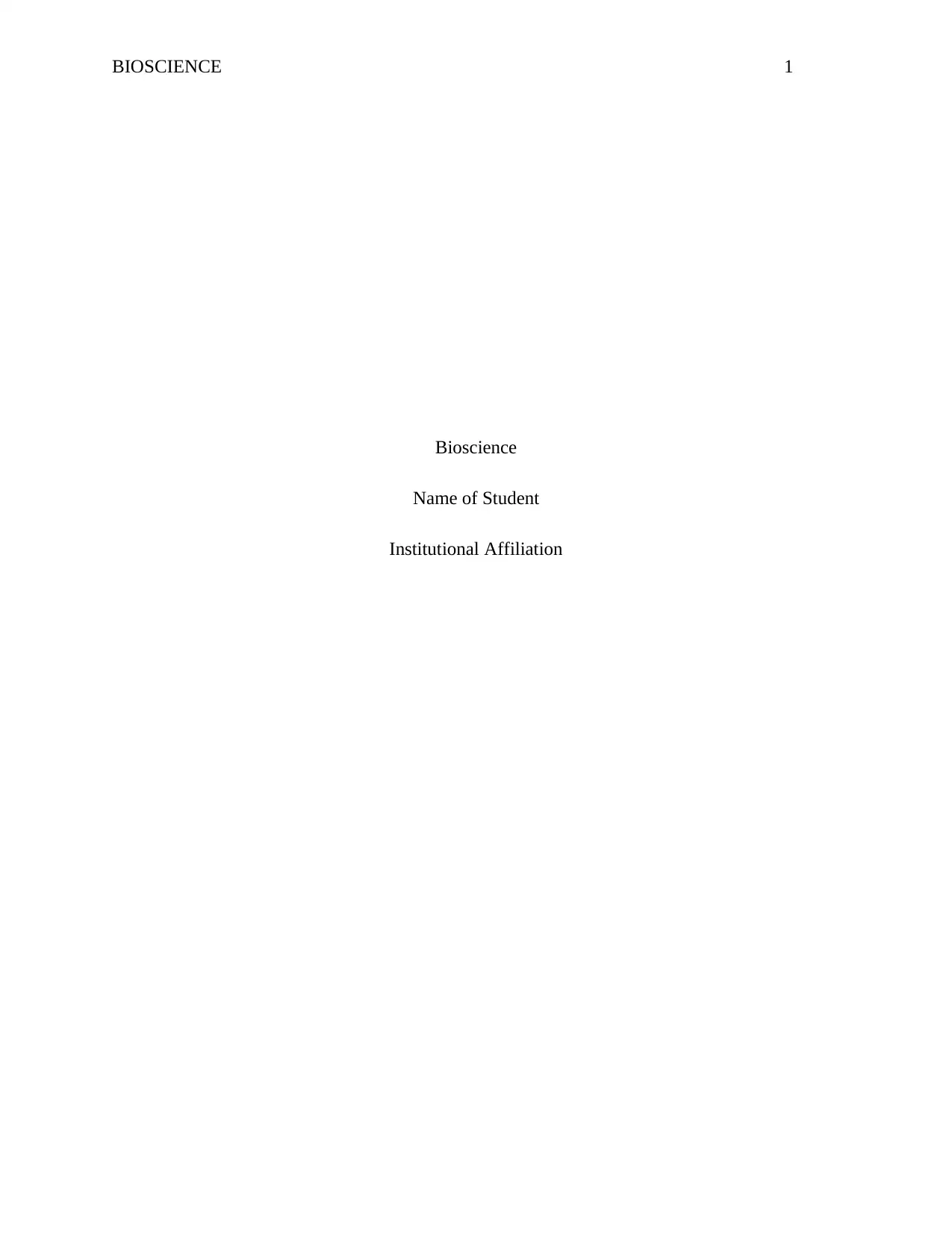
BIOSCIENCE 1
Bioscience
Name of Student
Institutional Affiliation
Bioscience
Name of Student
Institutional Affiliation
Secure Best Marks with AI Grader
Need help grading? Try our AI Grader for instant feedback on your assignments.

BIOSCIENCE 2
Bioscience
PART A - 300 words +/- 10% (20 marks)
1) Consider the following reaction at equilibrium
Hb (aq) + (g) « Hb (aq)
(a) Explain what is meant by a reaction at equilibrium. (2 marks)
- Equal amount of rate and reaction is the same for the product and the formation, another
word the rates of the forward and reverse reactions are the same ("Equilibrium
Expressions", 2019).
(b) In the lungs, where there is a high concentration of O2, in which direction will
equilibrium shift? (1 mark)
- Oxygen is transported throughout the body within the blood by haemoglobin (product).
High oxygen concentration shifts equilibrium to the right.
(c) In the tissues, where there is a low concentration of O2, in which direction will
equilibrium shift? (1 mark)
- Equilibrium shifts to the left at low CO2 concentration.
(d) In which direction will the equilibrium shift if there is a lower than normal level of
Hb in blood? (1 mark)
- Decreasing Hb concentration shifts equilibrium to the left
(e) Name and briefly explain the principle you applied in answering b) - d). (2 marks)
- La chaterlier's Principle, which states that changes taking place in a system in equilibrium
(pressure, temperature, or concentration) shifts equilibrium to the opposite direction to
counter that change. This restores the system to balance.
Bioscience
PART A - 300 words +/- 10% (20 marks)
1) Consider the following reaction at equilibrium
Hb (aq) + (g) « Hb (aq)
(a) Explain what is meant by a reaction at equilibrium. (2 marks)
- Equal amount of rate and reaction is the same for the product and the formation, another
word the rates of the forward and reverse reactions are the same ("Equilibrium
Expressions", 2019).
(b) In the lungs, where there is a high concentration of O2, in which direction will
equilibrium shift? (1 mark)
- Oxygen is transported throughout the body within the blood by haemoglobin (product).
High oxygen concentration shifts equilibrium to the right.
(c) In the tissues, where there is a low concentration of O2, in which direction will
equilibrium shift? (1 mark)
- Equilibrium shifts to the left at low CO2 concentration.
(d) In which direction will the equilibrium shift if there is a lower than normal level of
Hb in blood? (1 mark)
- Decreasing Hb concentration shifts equilibrium to the left
(e) Name and briefly explain the principle you applied in answering b) - d). (2 marks)
- La chaterlier's Principle, which states that changes taking place in a system in equilibrium
(pressure, temperature, or concentration) shifts equilibrium to the opposite direction to
counter that change. This restores the system to balance.
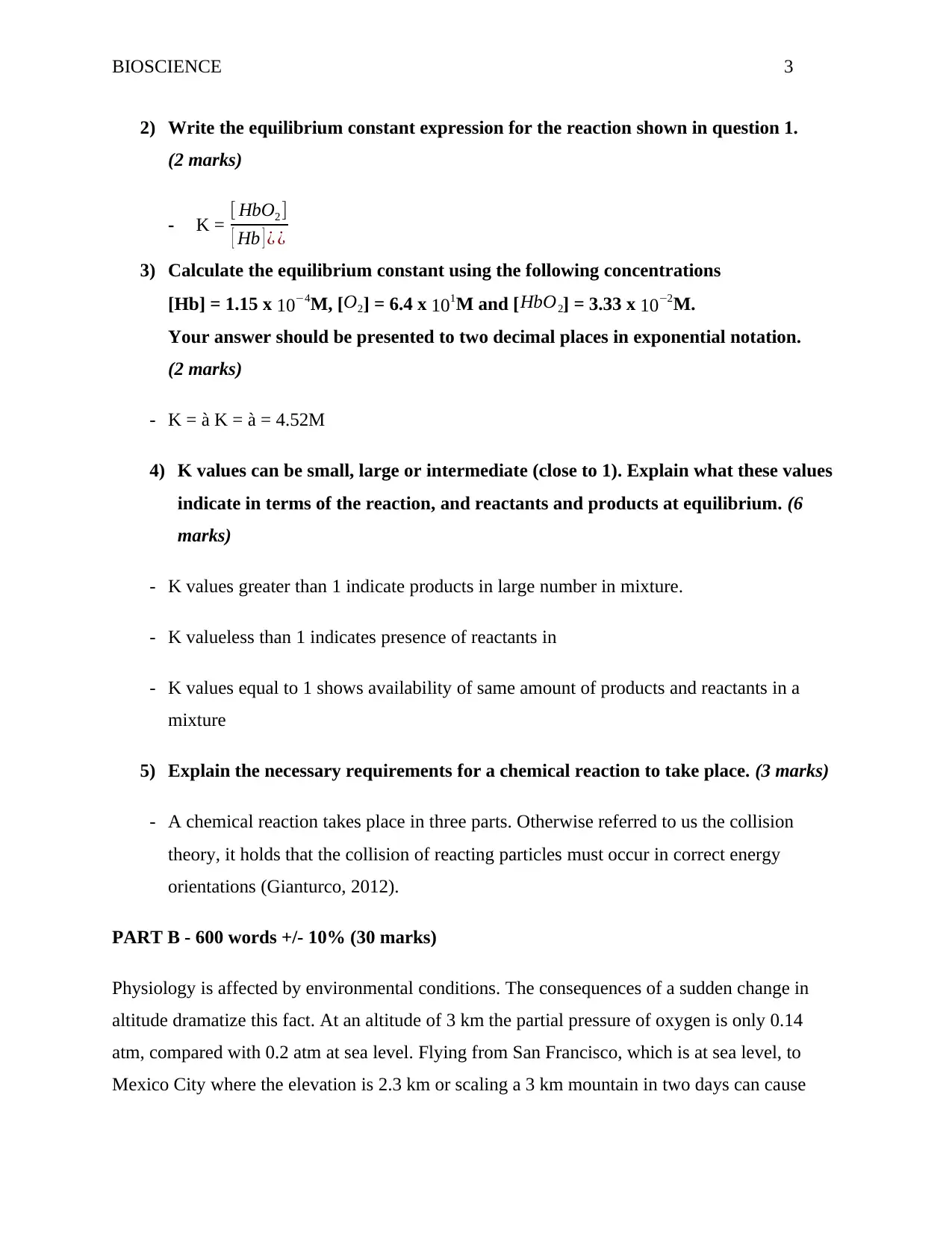
BIOSCIENCE 3
2) Write the equilibrium constant expression for the reaction shown in question 1.
(2 marks)
- K = [ HbO2 ]
[ Hb ] ¿ ¿
3) Calculate the equilibrium constant using the following concentrations
[Hb] = 1.15 x 10−4M, [ O2] = 6.4 x 101M and [ HbO2] = 3.33 x 10−2M.
Your answer should be presented to two decimal places in exponential notation.
(2 marks)
- K = à K = à = 4.52M
4) K values can be small, large or intermediate (close to 1). Explain what these values
indicate in terms of the reaction, and reactants and products at equilibrium. (6
marks)
- K values greater than 1 indicate products in large number in mixture.
- K valueless than 1 indicates presence of reactants in
- K values equal to 1 shows availability of same amount of products and reactants in a
mixture
5) Explain the necessary requirements for a chemical reaction to take place. (3 marks)
- A chemical reaction takes place in three parts. Otherwise referred to us the collision
theory, it holds that the collision of reacting particles must occur in correct energy
orientations (Gianturco, 2012).
PART B - 600 words +/- 10% (30 marks)
Physiology is affected by environmental conditions. The consequences of a sudden change in
altitude dramatize this fact. At an altitude of 3 km the partial pressure of oxygen is only 0.14
atm, compared with 0.2 atm at sea level. Flying from San Francisco, which is at sea level, to
Mexico City where the elevation is 2.3 km or scaling a 3 km mountain in two days can cause
2) Write the equilibrium constant expression for the reaction shown in question 1.
(2 marks)
- K = [ HbO2 ]
[ Hb ] ¿ ¿
3) Calculate the equilibrium constant using the following concentrations
[Hb] = 1.15 x 10−4M, [ O2] = 6.4 x 101M and [ HbO2] = 3.33 x 10−2M.
Your answer should be presented to two decimal places in exponential notation.
(2 marks)
- K = à K = à = 4.52M
4) K values can be small, large or intermediate (close to 1). Explain what these values
indicate in terms of the reaction, and reactants and products at equilibrium. (6
marks)
- K values greater than 1 indicate products in large number in mixture.
- K valueless than 1 indicates presence of reactants in
- K values equal to 1 shows availability of same amount of products and reactants in a
mixture
5) Explain the necessary requirements for a chemical reaction to take place. (3 marks)
- A chemical reaction takes place in three parts. Otherwise referred to us the collision
theory, it holds that the collision of reacting particles must occur in correct energy
orientations (Gianturco, 2012).
PART B - 600 words +/- 10% (30 marks)
Physiology is affected by environmental conditions. The consequences of a sudden change in
altitude dramatize this fact. At an altitude of 3 km the partial pressure of oxygen is only 0.14
atm, compared with 0.2 atm at sea level. Flying from San Francisco, which is at sea level, to
Mexico City where the elevation is 2.3 km or scaling a 3 km mountain in two days can cause
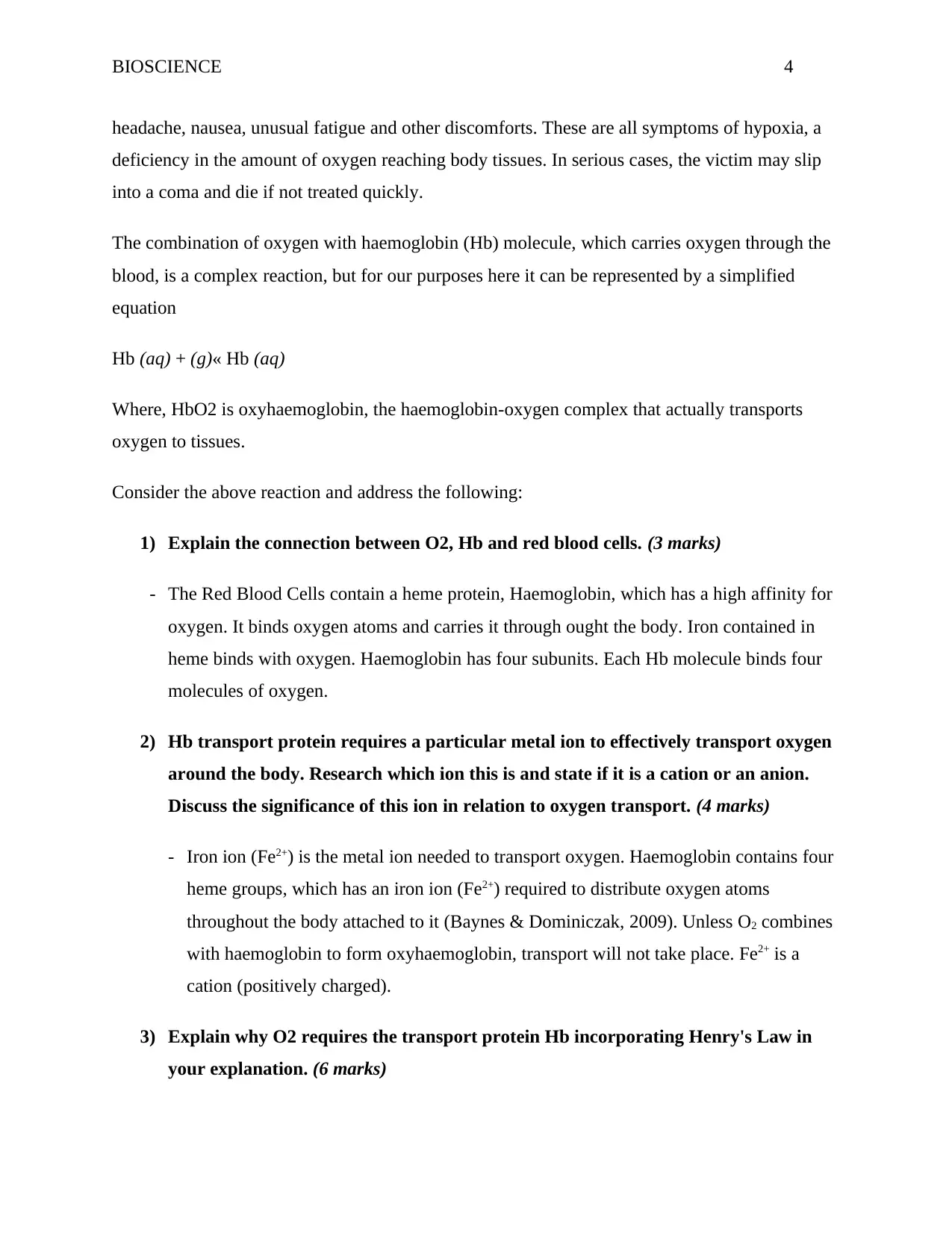
BIOSCIENCE 4
headache, nausea, unusual fatigue and other discomforts. These are all symptoms of hypoxia, a
deficiency in the amount of oxygen reaching body tissues. In serious cases, the victim may slip
into a coma and die if not treated quickly.
The combination of oxygen with haemoglobin (Hb) molecule, which carries oxygen through the
blood, is a complex reaction, but for our purposes here it can be represented by a simplified
equation
Hb (aq) + (g)« Hb (aq)
Where, HbO2 is oxyhaemoglobin, the haemoglobin-oxygen complex that actually transports
oxygen to tissues.
Consider the above reaction and address the following:
1) Explain the connection between O2, Hb and red blood cells. (3 marks)
- The Red Blood Cells contain a heme protein, Haemoglobin, which has a high affinity for
oxygen. It binds oxygen atoms and carries it through ought the body. Iron contained in
heme binds with oxygen. Haemoglobin has four subunits. Each Hb molecule binds four
molecules of oxygen.
2) Hb transport protein requires a particular metal ion to effectively transport oxygen
around the body. Research which ion this is and state if it is a cation or an anion.
Discuss the significance of this ion in relation to oxygen transport. (4 marks)
- Iron ion (Fe2+) is the metal ion needed to transport oxygen. Haemoglobin contains four
heme groups, which has an iron ion (Fe2+) required to distribute oxygen atoms
throughout the body attached to it (Baynes & Dominiczak, 2009). Unless O2 combines
with haemoglobin to form oxyhaemoglobin, transport will not take place. Fe2+ is a
cation (positively charged).
3) Explain why O2 requires the transport protein Hb incorporating Henry's Law in
your explanation. (6 marks)
headache, nausea, unusual fatigue and other discomforts. These are all symptoms of hypoxia, a
deficiency in the amount of oxygen reaching body tissues. In serious cases, the victim may slip
into a coma and die if not treated quickly.
The combination of oxygen with haemoglobin (Hb) molecule, which carries oxygen through the
blood, is a complex reaction, but for our purposes here it can be represented by a simplified
equation
Hb (aq) + (g)« Hb (aq)
Where, HbO2 is oxyhaemoglobin, the haemoglobin-oxygen complex that actually transports
oxygen to tissues.
Consider the above reaction and address the following:
1) Explain the connection between O2, Hb and red blood cells. (3 marks)
- The Red Blood Cells contain a heme protein, Haemoglobin, which has a high affinity for
oxygen. It binds oxygen atoms and carries it through ought the body. Iron contained in
heme binds with oxygen. Haemoglobin has four subunits. Each Hb molecule binds four
molecules of oxygen.
2) Hb transport protein requires a particular metal ion to effectively transport oxygen
around the body. Research which ion this is and state if it is a cation or an anion.
Discuss the significance of this ion in relation to oxygen transport. (4 marks)
- Iron ion (Fe2+) is the metal ion needed to transport oxygen. Haemoglobin contains four
heme groups, which has an iron ion (Fe2+) required to distribute oxygen atoms
throughout the body attached to it (Baynes & Dominiczak, 2009). Unless O2 combines
with haemoglobin to form oxyhaemoglobin, transport will not take place. Fe2+ is a
cation (positively charged).
3) Explain why O2 requires the transport protein Hb incorporating Henry's Law in
your explanation. (6 marks)
Secure Best Marks with AI Grader
Need help grading? Try our AI Grader for instant feedback on your assignments.
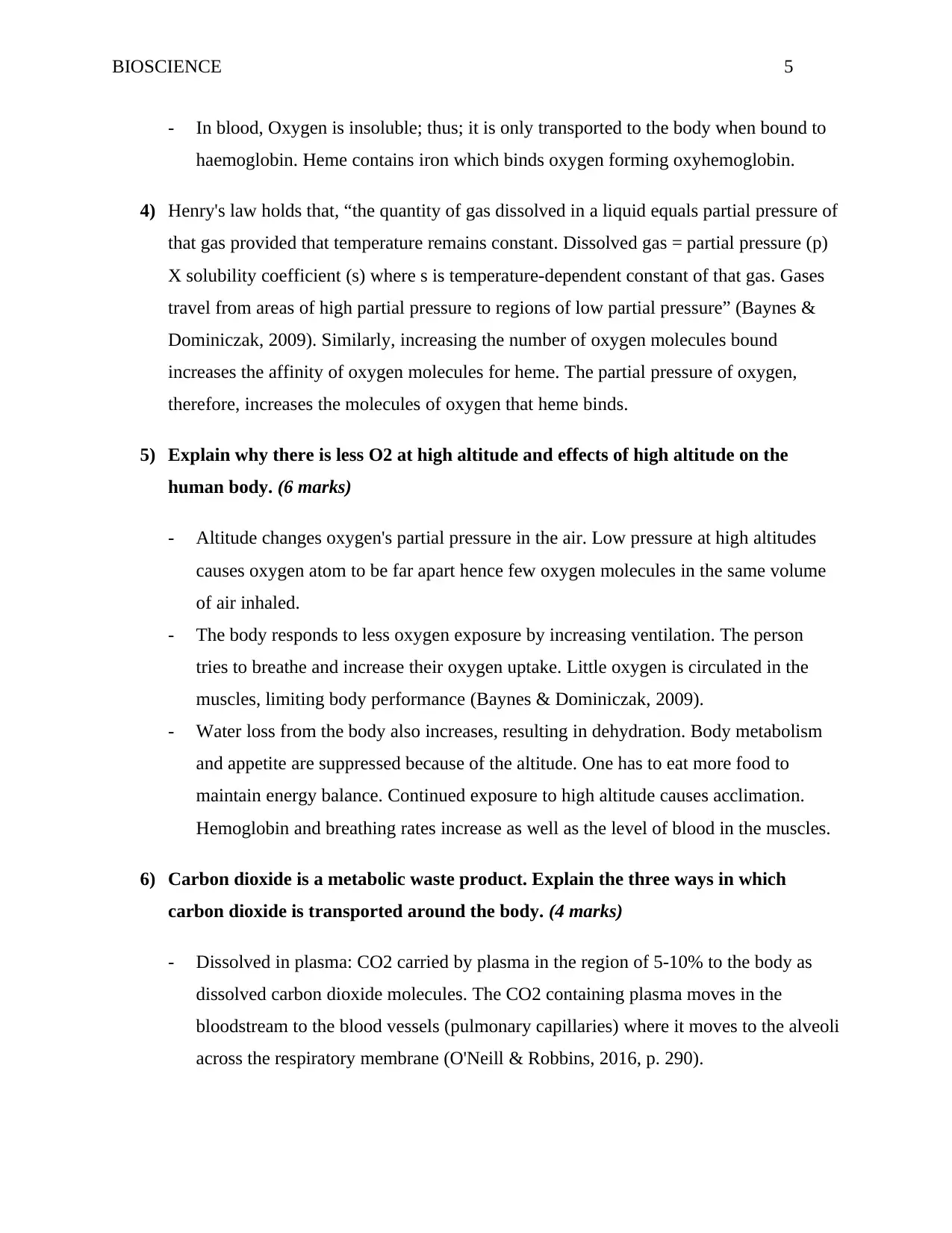
BIOSCIENCE 5
- In blood, Oxygen is insoluble; thus; it is only transported to the body when bound to
haemoglobin. Heme contains iron which binds oxygen forming oxyhemoglobin.
4) Henry's law holds that, “the quantity of gas dissolved in a liquid equals partial pressure of
that gas provided that temperature remains constant. Dissolved gas = partial pressure (p)
X solubility coefficient (s) where s is temperature-dependent constant of that gas. Gases
travel from areas of high partial pressure to regions of low partial pressure” (Baynes &
Dominiczak, 2009). Similarly, increasing the number of oxygen molecules bound
increases the affinity of oxygen molecules for heme. The partial pressure of oxygen,
therefore, increases the molecules of oxygen that heme binds.
5) Explain why there is less O2 at high altitude and effects of high altitude on the
human body. (6 marks)
- Altitude changes oxygen's partial pressure in the air. Low pressure at high altitudes
causes oxygen atom to be far apart hence few oxygen molecules in the same volume
of air inhaled.
- The body responds to less oxygen exposure by increasing ventilation. The person
tries to breathe and increase their oxygen uptake. Little oxygen is circulated in the
muscles, limiting body performance (Baynes & Dominiczak, 2009).
- Water loss from the body also increases, resulting in dehydration. Body metabolism
and appetite are suppressed because of the altitude. One has to eat more food to
maintain energy balance. Continued exposure to high altitude causes acclimation.
Hemoglobin and breathing rates increase as well as the level of blood in the muscles.
6) Carbon dioxide is a metabolic waste product. Explain the three ways in which
carbon dioxide is transported around the body. (4 marks)
- Dissolved in plasma: CO2 carried by plasma in the region of 5-10% to the body as
dissolved carbon dioxide molecules. The CO2 containing plasma moves in the
bloodstream to the blood vessels (pulmonary capillaries) where it moves to the alveoli
across the respiratory membrane (O'Neill & Robbins, 2016, p. 290).
- In blood, Oxygen is insoluble; thus; it is only transported to the body when bound to
haemoglobin. Heme contains iron which binds oxygen forming oxyhemoglobin.
4) Henry's law holds that, “the quantity of gas dissolved in a liquid equals partial pressure of
that gas provided that temperature remains constant. Dissolved gas = partial pressure (p)
X solubility coefficient (s) where s is temperature-dependent constant of that gas. Gases
travel from areas of high partial pressure to regions of low partial pressure” (Baynes &
Dominiczak, 2009). Similarly, increasing the number of oxygen molecules bound
increases the affinity of oxygen molecules for heme. The partial pressure of oxygen,
therefore, increases the molecules of oxygen that heme binds.
5) Explain why there is less O2 at high altitude and effects of high altitude on the
human body. (6 marks)
- Altitude changes oxygen's partial pressure in the air. Low pressure at high altitudes
causes oxygen atom to be far apart hence few oxygen molecules in the same volume
of air inhaled.
- The body responds to less oxygen exposure by increasing ventilation. The person
tries to breathe and increase their oxygen uptake. Little oxygen is circulated in the
muscles, limiting body performance (Baynes & Dominiczak, 2009).
- Water loss from the body also increases, resulting in dehydration. Body metabolism
and appetite are suppressed because of the altitude. One has to eat more food to
maintain energy balance. Continued exposure to high altitude causes acclimation.
Hemoglobin and breathing rates increase as well as the level of blood in the muscles.
6) Carbon dioxide is a metabolic waste product. Explain the three ways in which
carbon dioxide is transported around the body. (4 marks)
- Dissolved in plasma: CO2 carried by plasma in the region of 5-10% to the body as
dissolved carbon dioxide molecules. The CO2 containing plasma moves in the
bloodstream to the blood vessels (pulmonary capillaries) where it moves to the alveoli
across the respiratory membrane (O'Neill & Robbins, 2016, p. 290).
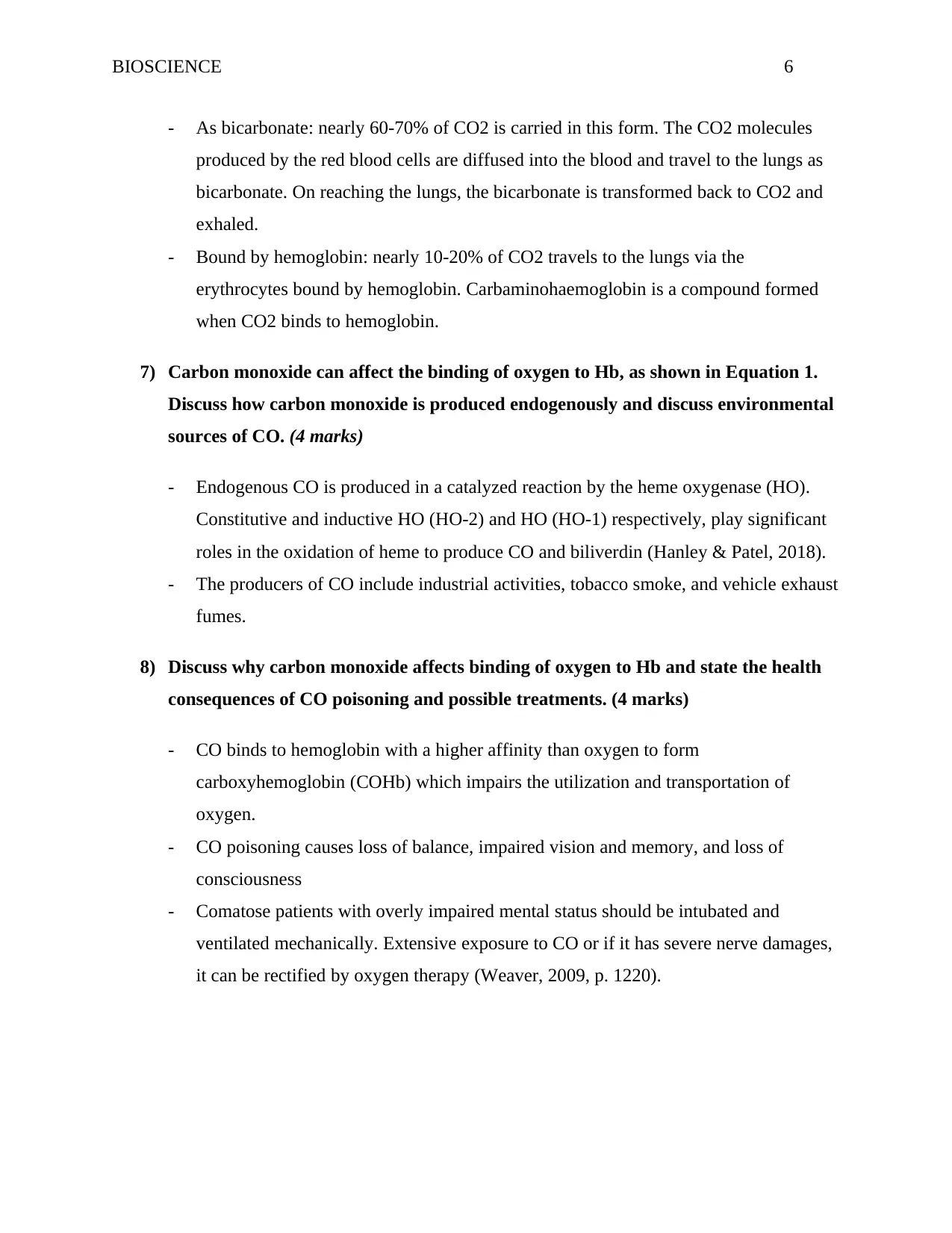
BIOSCIENCE 6
- As bicarbonate: nearly 60-70% of CO2 is carried in this form. The CO2 molecules
produced by the red blood cells are diffused into the blood and travel to the lungs as
bicarbonate. On reaching the lungs, the bicarbonate is transformed back to CO2 and
exhaled.
- Bound by hemoglobin: nearly 10-20% of CO2 travels to the lungs via the
erythrocytes bound by hemoglobin. Carbaminohaemoglobin is a compound formed
when CO2 binds to hemoglobin.
7) Carbon monoxide can affect the binding of oxygen to Hb, as shown in Equation 1.
Discuss how carbon monoxide is produced endogenously and discuss environmental
sources of CO. (4 marks)
- Endogenous CO is produced in a catalyzed reaction by the heme oxygenase (HO).
Constitutive and inductive HO (HO-2) and HO (HO-1) respectively, play significant
roles in the oxidation of heme to produce CO and biliverdin (Hanley & Patel, 2018).
- The producers of CO include industrial activities, tobacco smoke, and vehicle exhaust
fumes.
8) Discuss why carbon monoxide affects binding of oxygen to Hb and state the health
consequences of CO poisoning and possible treatments. (4 marks)
- CO binds to hemoglobin with a higher affinity than oxygen to form
carboxyhemoglobin (COHb) which impairs the utilization and transportation of
oxygen.
- CO poisoning causes loss of balance, impaired vision and memory, and loss of
consciousness
- Comatose patients with overly impaired mental status should be intubated and
ventilated mechanically. Extensive exposure to CO or if it has severe nerve damages,
it can be rectified by oxygen therapy (Weaver, 2009, p. 1220).
- As bicarbonate: nearly 60-70% of CO2 is carried in this form. The CO2 molecules
produced by the red blood cells are diffused into the blood and travel to the lungs as
bicarbonate. On reaching the lungs, the bicarbonate is transformed back to CO2 and
exhaled.
- Bound by hemoglobin: nearly 10-20% of CO2 travels to the lungs via the
erythrocytes bound by hemoglobin. Carbaminohaemoglobin is a compound formed
when CO2 binds to hemoglobin.
7) Carbon monoxide can affect the binding of oxygen to Hb, as shown in Equation 1.
Discuss how carbon monoxide is produced endogenously and discuss environmental
sources of CO. (4 marks)
- Endogenous CO is produced in a catalyzed reaction by the heme oxygenase (HO).
Constitutive and inductive HO (HO-2) and HO (HO-1) respectively, play significant
roles in the oxidation of heme to produce CO and biliverdin (Hanley & Patel, 2018).
- The producers of CO include industrial activities, tobacco smoke, and vehicle exhaust
fumes.
8) Discuss why carbon monoxide affects binding of oxygen to Hb and state the health
consequences of CO poisoning and possible treatments. (4 marks)
- CO binds to hemoglobin with a higher affinity than oxygen to form
carboxyhemoglobin (COHb) which impairs the utilization and transportation of
oxygen.
- CO poisoning causes loss of balance, impaired vision and memory, and loss of
consciousness
- Comatose patients with overly impaired mental status should be intubated and
ventilated mechanically. Extensive exposure to CO or if it has severe nerve damages,
it can be rectified by oxygen therapy (Weaver, 2009, p. 1220).
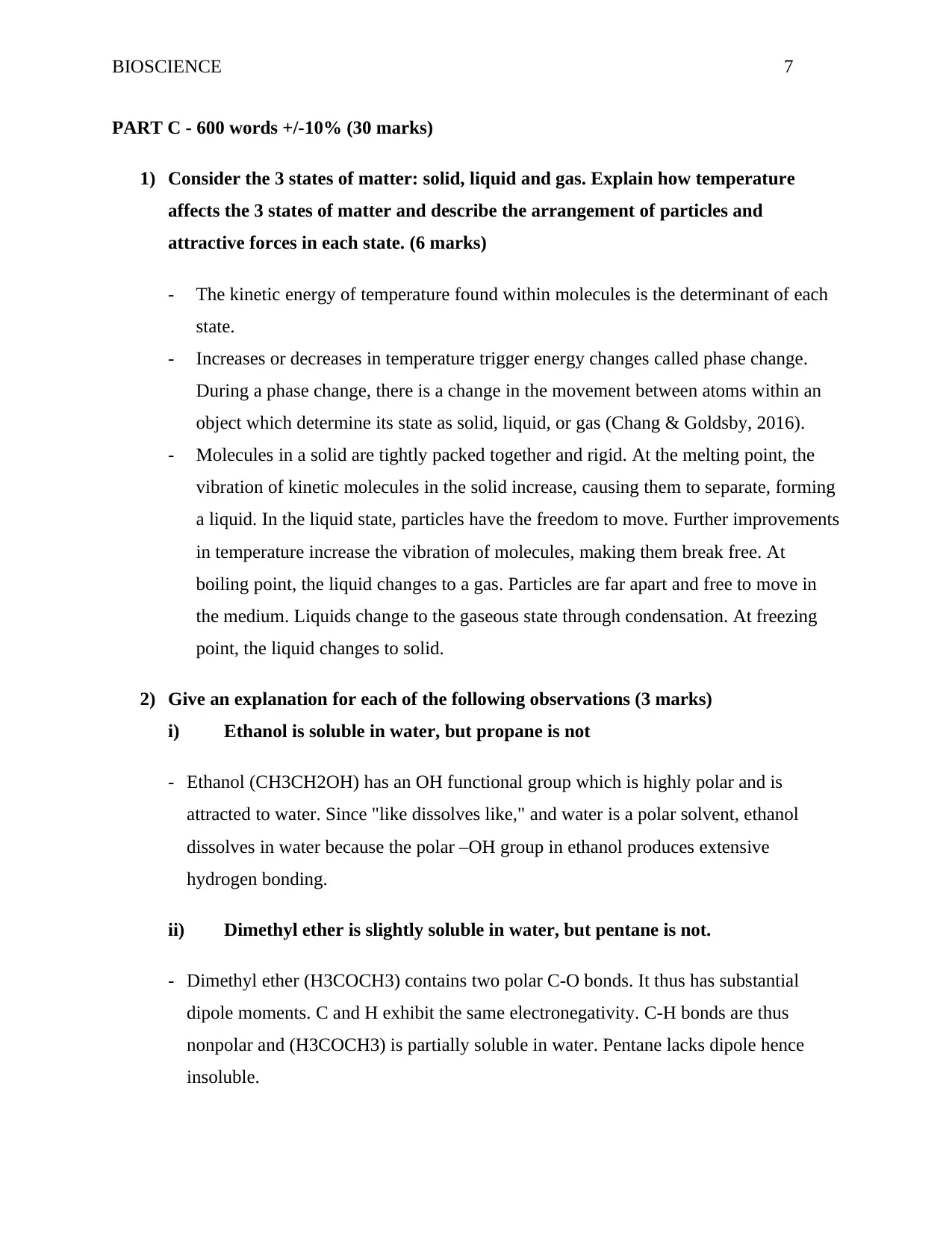
BIOSCIENCE 7
PART C - 600 words +/-10% (30 marks)
1) Consider the 3 states of matter: solid, liquid and gas. Explain how temperature
affects the 3 states of matter and describe the arrangement of particles and
attractive forces in each state. (6 marks)
- The kinetic energy of temperature found within molecules is the determinant of each
state.
- Increases or decreases in temperature trigger energy changes called phase change.
During a phase change, there is a change in the movement between atoms within an
object which determine its state as solid, liquid, or gas (Chang & Goldsby, 2016).
- Molecules in a solid are tightly packed together and rigid. At the melting point, the
vibration of kinetic molecules in the solid increase, causing them to separate, forming
a liquid. In the liquid state, particles have the freedom to move. Further improvements
in temperature increase the vibration of molecules, making them break free. At
boiling point, the liquid changes to a gas. Particles are far apart and free to move in
the medium. Liquids change to the gaseous state through condensation. At freezing
point, the liquid changes to solid.
2) Give an explanation for each of the following observations (3 marks)
i) Ethanol is soluble in water, but propane is not
- Ethanol (CH3CH2OH) has an OH functional group which is highly polar and is
attracted to water. Since "like dissolves like," and water is a polar solvent, ethanol
dissolves in water because the polar –OH group in ethanol produces extensive
hydrogen bonding.
ii) Dimethyl ether is slightly soluble in water, but pentane is not.
- Dimethyl ether (H3COCH3) contains two polar C-O bonds. It thus has substantial
dipole moments. C and H exhibit the same electronegativity. C-H bonds are thus
nonpolar and (H3COCH3) is partially soluble in water. Pentane lacks dipole hence
insoluble.
PART C - 600 words +/-10% (30 marks)
1) Consider the 3 states of matter: solid, liquid and gas. Explain how temperature
affects the 3 states of matter and describe the arrangement of particles and
attractive forces in each state. (6 marks)
- The kinetic energy of temperature found within molecules is the determinant of each
state.
- Increases or decreases in temperature trigger energy changes called phase change.
During a phase change, there is a change in the movement between atoms within an
object which determine its state as solid, liquid, or gas (Chang & Goldsby, 2016).
- Molecules in a solid are tightly packed together and rigid. At the melting point, the
vibration of kinetic molecules in the solid increase, causing them to separate, forming
a liquid. In the liquid state, particles have the freedom to move. Further improvements
in temperature increase the vibration of molecules, making them break free. At
boiling point, the liquid changes to a gas. Particles are far apart and free to move in
the medium. Liquids change to the gaseous state through condensation. At freezing
point, the liquid changes to solid.
2) Give an explanation for each of the following observations (3 marks)
i) Ethanol is soluble in water, but propane is not
- Ethanol (CH3CH2OH) has an OH functional group which is highly polar and is
attracted to water. Since "like dissolves like," and water is a polar solvent, ethanol
dissolves in water because the polar –OH group in ethanol produces extensive
hydrogen bonding.
ii) Dimethyl ether is slightly soluble in water, but pentane is not.
- Dimethyl ether (H3COCH3) contains two polar C-O bonds. It thus has substantial
dipole moments. C and H exhibit the same electronegativity. C-H bonds are thus
nonpolar and (H3COCH3) is partially soluble in water. Pentane lacks dipole hence
insoluble.
Paraphrase This Document
Need a fresh take? Get an instant paraphrase of this document with our AI Paraphraser
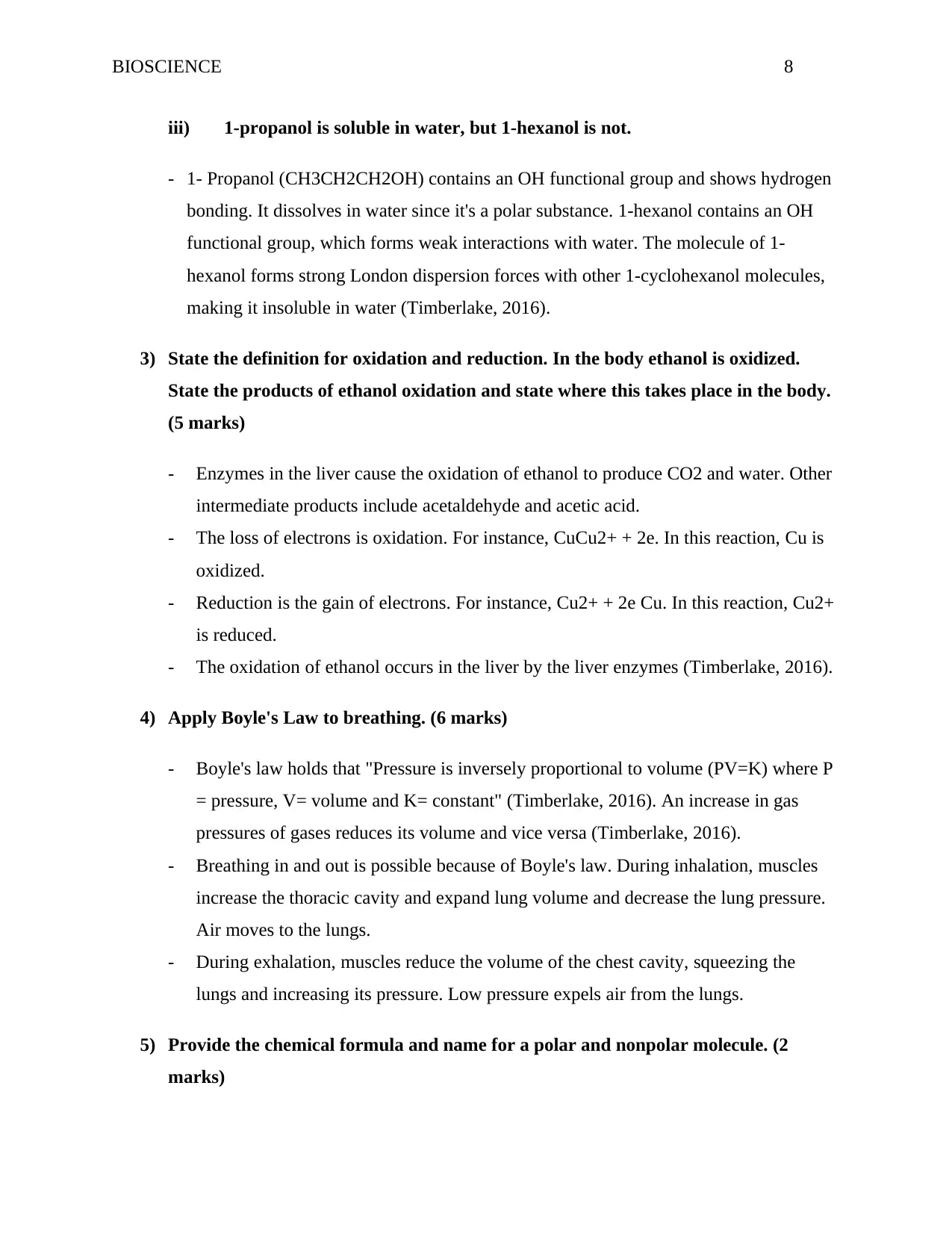
BIOSCIENCE 8
iii) 1-propanol is soluble in water, but 1-hexanol is not.
- 1- Propanol (CH3CH2CH2OH) contains an OH functional group and shows hydrogen
bonding. It dissolves in water since it's a polar substance. 1-hexanol contains an OH
functional group, which forms weak interactions with water. The molecule of 1-
hexanol forms strong London dispersion forces with other 1-cyclohexanol molecules,
making it insoluble in water (Timberlake, 2016).
3) State the definition for oxidation and reduction. In the body ethanol is oxidized.
State the products of ethanol oxidation and state where this takes place in the body.
(5 marks)
- Enzymes in the liver cause the oxidation of ethanol to produce CO2 and water. Other
intermediate products include acetaldehyde and acetic acid.
- The loss of electrons is oxidation. For instance, CuCu2+ + 2e. In this reaction, Cu is
oxidized.
- Reduction is the gain of electrons. For instance, Cu2+ + 2e Cu. In this reaction, Cu2+
is reduced.
- The oxidation of ethanol occurs in the liver by the liver enzymes (Timberlake, 2016).
4) Apply Boyle's Law to breathing. (6 marks)
- Boyle's law holds that "Pressure is inversely proportional to volume (PV=K) where P
= pressure, V= volume and K= constant" (Timberlake, 2016). An increase in gas
pressures of gases reduces its volume and vice versa (Timberlake, 2016).
- Breathing in and out is possible because of Boyle's law. During inhalation, muscles
increase the thoracic cavity and expand lung volume and decrease the lung pressure.
Air moves to the lungs.
- During exhalation, muscles reduce the volume of the chest cavity, squeezing the
lungs and increasing its pressure. Low pressure expels air from the lungs.
5) Provide the chemical formula and name for a polar and nonpolar molecule. (2
marks)
iii) 1-propanol is soluble in water, but 1-hexanol is not.
- 1- Propanol (CH3CH2CH2OH) contains an OH functional group and shows hydrogen
bonding. It dissolves in water since it's a polar substance. 1-hexanol contains an OH
functional group, which forms weak interactions with water. The molecule of 1-
hexanol forms strong London dispersion forces with other 1-cyclohexanol molecules,
making it insoluble in water (Timberlake, 2016).
3) State the definition for oxidation and reduction. In the body ethanol is oxidized.
State the products of ethanol oxidation and state where this takes place in the body.
(5 marks)
- Enzymes in the liver cause the oxidation of ethanol to produce CO2 and water. Other
intermediate products include acetaldehyde and acetic acid.
- The loss of electrons is oxidation. For instance, CuCu2+ + 2e. In this reaction, Cu is
oxidized.
- Reduction is the gain of electrons. For instance, Cu2+ + 2e Cu. In this reaction, Cu2+
is reduced.
- The oxidation of ethanol occurs in the liver by the liver enzymes (Timberlake, 2016).
4) Apply Boyle's Law to breathing. (6 marks)
- Boyle's law holds that "Pressure is inversely proportional to volume (PV=K) where P
= pressure, V= volume and K= constant" (Timberlake, 2016). An increase in gas
pressures of gases reduces its volume and vice versa (Timberlake, 2016).
- Breathing in and out is possible because of Boyle's law. During inhalation, muscles
increase the thoracic cavity and expand lung volume and decrease the lung pressure.
Air moves to the lungs.
- During exhalation, muscles reduce the volume of the chest cavity, squeezing the
lungs and increasing its pressure. Low pressure expels air from the lungs.
5) Provide the chemical formula and name for a polar and nonpolar molecule. (2
marks)
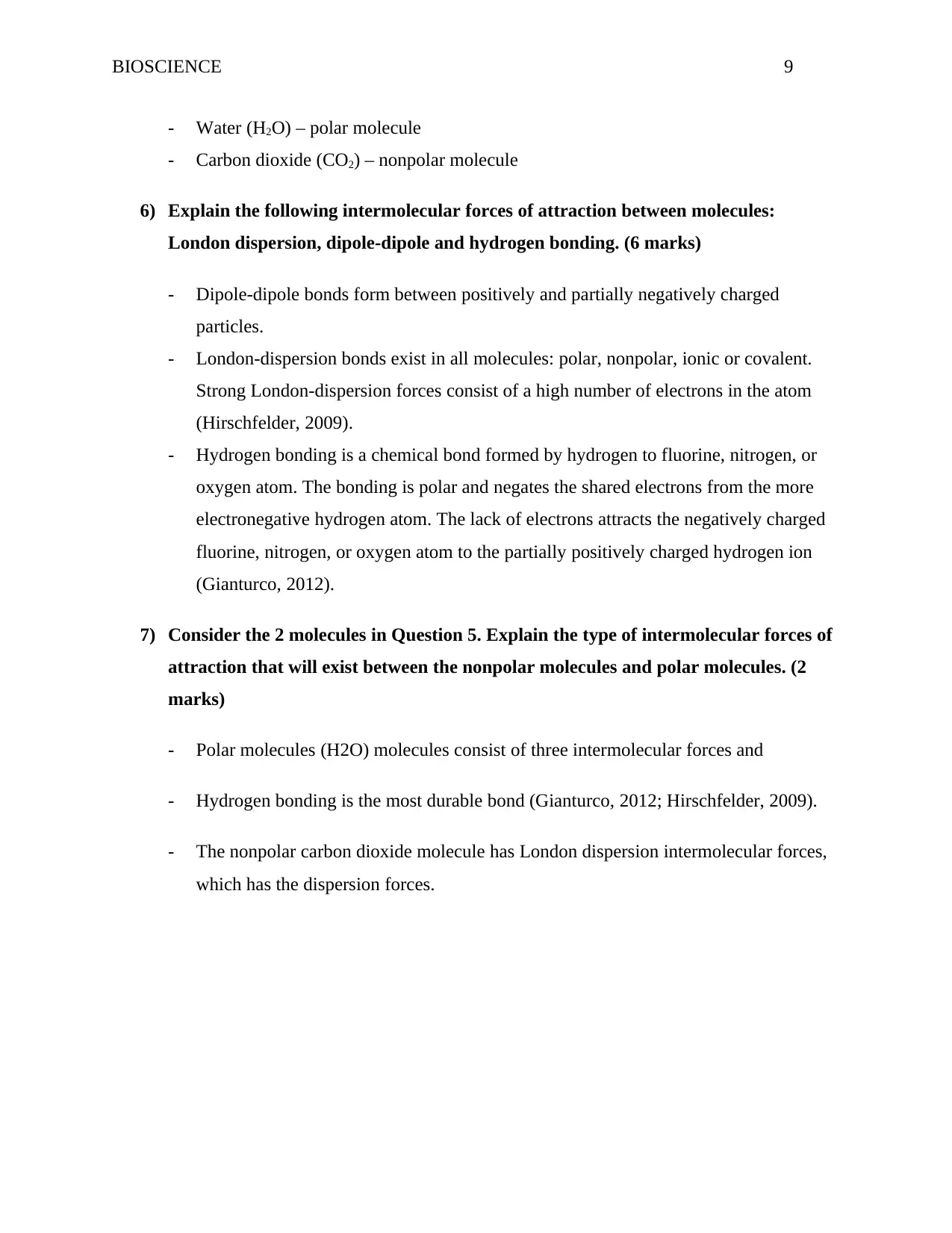
BIOSCIENCE 9
- Water (H2O) – polar molecule
- Carbon dioxide (CO2) – nonpolar molecule
6) Explain the following intermolecular forces of attraction between molecules:
London dispersion, dipole-dipole and hydrogen bonding. (6 marks)
- Dipole-dipole bonds form between positively and partially negatively charged
particles.
- London-dispersion bonds exist in all molecules: polar, nonpolar, ionic or covalent.
Strong London-dispersion forces consist of a high number of electrons in the atom
(Hirschfelder, 2009).
- Hydrogen bonding is a chemical bond formed by hydrogen to fluorine, nitrogen, or
oxygen atom. The bonding is polar and negates the shared electrons from the more
electronegative hydrogen atom. The lack of electrons attracts the negatively charged
fluorine, nitrogen, or oxygen atom to the partially positively charged hydrogen ion
(Gianturco, 2012).
7) Consider the 2 molecules in Question 5. Explain the type of intermolecular forces of
attraction that will exist between the nonpolar molecules and polar molecules. (2
marks)
- Polar molecules (H2O) molecules consist of three intermolecular forces and
- Hydrogen bonding is the most durable bond (Gianturco, 2012; Hirschfelder, 2009).
- The nonpolar carbon dioxide molecule has London dispersion intermolecular forces,
which has the dispersion forces.
- Water (H2O) – polar molecule
- Carbon dioxide (CO2) – nonpolar molecule
6) Explain the following intermolecular forces of attraction between molecules:
London dispersion, dipole-dipole and hydrogen bonding. (6 marks)
- Dipole-dipole bonds form between positively and partially negatively charged
particles.
- London-dispersion bonds exist in all molecules: polar, nonpolar, ionic or covalent.
Strong London-dispersion forces consist of a high number of electrons in the atom
(Hirschfelder, 2009).
- Hydrogen bonding is a chemical bond formed by hydrogen to fluorine, nitrogen, or
oxygen atom. The bonding is polar and negates the shared electrons from the more
electronegative hydrogen atom. The lack of electrons attracts the negatively charged
fluorine, nitrogen, or oxygen atom to the partially positively charged hydrogen ion
(Gianturco, 2012).
7) Consider the 2 molecules in Question 5. Explain the type of intermolecular forces of
attraction that will exist between the nonpolar molecules and polar molecules. (2
marks)
- Polar molecules (H2O) molecules consist of three intermolecular forces and
- Hydrogen bonding is the most durable bond (Gianturco, 2012; Hirschfelder, 2009).
- The nonpolar carbon dioxide molecule has London dispersion intermolecular forces,
which has the dispersion forces.
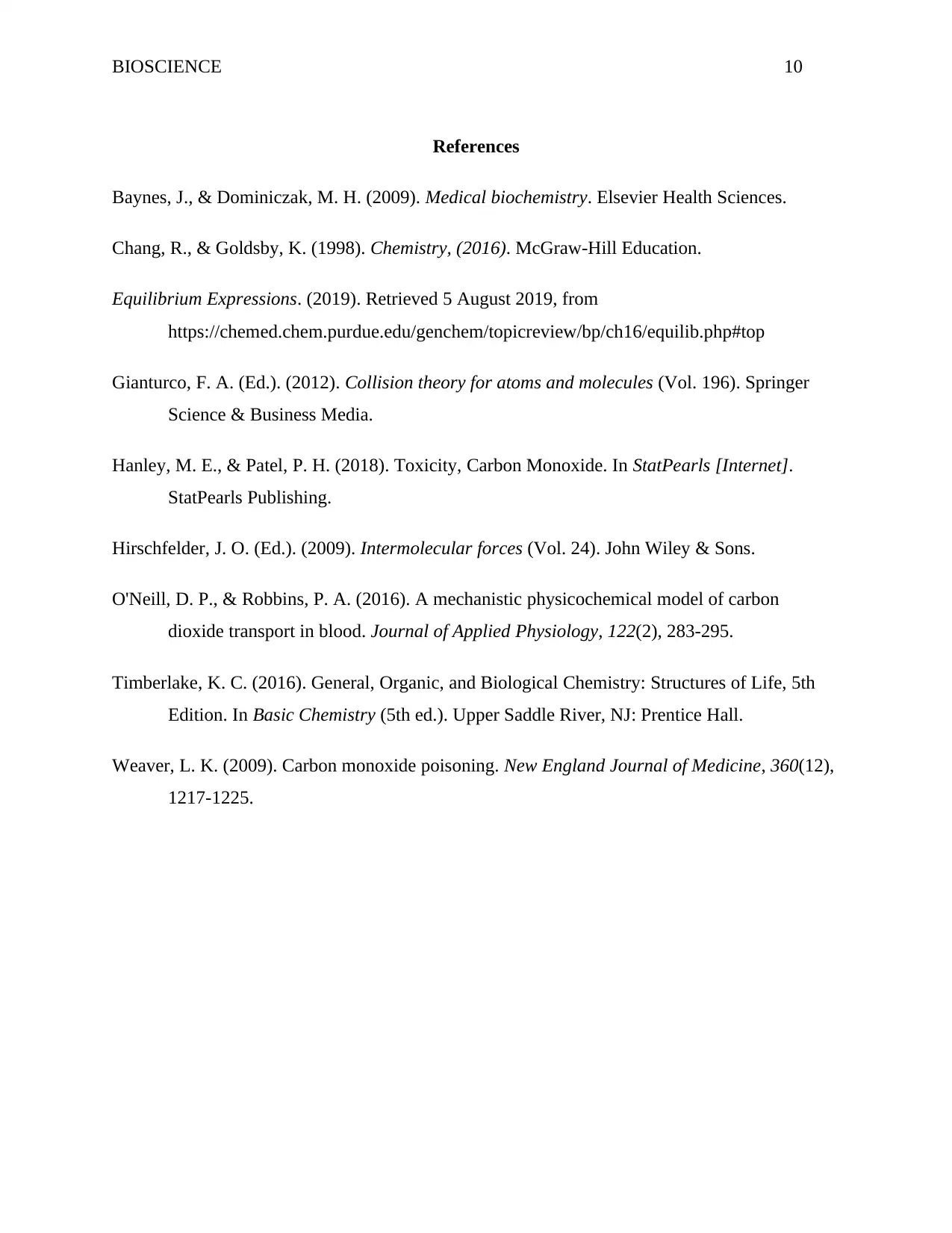
BIOSCIENCE 10
References
Baynes, J., & Dominiczak, M. H. (2009). Medical biochemistry. Elsevier Health Sciences.
Chang, R., & Goldsby, K. (1998). Chemistry, (2016). McGraw-Hill Education.
Equilibrium Expressions. (2019). Retrieved 5 August 2019, from
https://chemed.chem.purdue.edu/genchem/topicreview/bp/ch16/equilib.php#top
Gianturco, F. A. (Ed.). (2012). Collision theory for atoms and molecules (Vol. 196). Springer
Science & Business Media.
Hanley, M. E., & Patel, P. H. (2018). Toxicity, Carbon Monoxide. In StatPearls [Internet].
StatPearls Publishing.
Hirschfelder, J. O. (Ed.). (2009). Intermolecular forces (Vol. 24). John Wiley & Sons.
O'Neill, D. P., & Robbins, P. A. (2016). A mechanistic physicochemical model of carbon
dioxide transport in blood. Journal of Applied Physiology, 122(2), 283-295.
Timberlake, K. C. (2016). General, Organic, and Biological Chemistry: Structures of Life, 5th
Edition. In Basic Chemistry (5th ed.). Upper Saddle River, NJ: Prentice Hall.
Weaver, L. K. (2009). Carbon monoxide poisoning. New England Journal of Medicine, 360(12),
1217-1225.
References
Baynes, J., & Dominiczak, M. H. (2009). Medical biochemistry. Elsevier Health Sciences.
Chang, R., & Goldsby, K. (1998). Chemistry, (2016). McGraw-Hill Education.
Equilibrium Expressions. (2019). Retrieved 5 August 2019, from
https://chemed.chem.purdue.edu/genchem/topicreview/bp/ch16/equilib.php#top
Gianturco, F. A. (Ed.). (2012). Collision theory for atoms and molecules (Vol. 196). Springer
Science & Business Media.
Hanley, M. E., & Patel, P. H. (2018). Toxicity, Carbon Monoxide. In StatPearls [Internet].
StatPearls Publishing.
Hirschfelder, J. O. (Ed.). (2009). Intermolecular forces (Vol. 24). John Wiley & Sons.
O'Neill, D. P., & Robbins, P. A. (2016). A mechanistic physicochemical model of carbon
dioxide transport in blood. Journal of Applied Physiology, 122(2), 283-295.
Timberlake, K. C. (2016). General, Organic, and Biological Chemistry: Structures of Life, 5th
Edition. In Basic Chemistry (5th ed.). Upper Saddle River, NJ: Prentice Hall.
Weaver, L. K. (2009). Carbon monoxide poisoning. New England Journal of Medicine, 360(12),
1217-1225.
1 out of 10
Related Documents
Your All-in-One AI-Powered Toolkit for Academic Success.
+13062052269
info@desklib.com
Available 24*7 on WhatsApp / Email
![[object Object]](/_next/static/media/star-bottom.7253800d.svg)
Unlock your academic potential
© 2024 | Zucol Services PVT LTD | All rights reserved.
